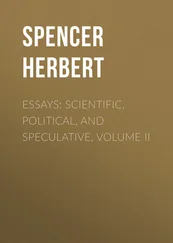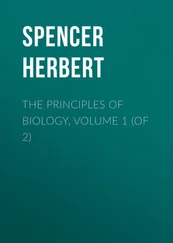Next to be considered come phenomena, the bearings of which on the question before us are scarcely considered—I mean those presented by meteors and shooting stars. The natures and distributions of these harmonize with the hypothesis of an exploded planet, and I think with no other hypothesis. The theory of volcanic origin, joined with the remark that the Sun emits jets which might propel them with adequate velocities, seems quite untenable. Such meteoric bodies as have descended to us, forbid absolutely the supposition of solar origin. Nor can they rationally be ascribed to planetary volcanoes. Even were their mineral characters appropriate, which many of them are not (for volcanoes do not eject iron), no planetary volcanoes could propel them with anything like the implied velocity—could no more withstand the tremendous force to be assumed, than could a card-board gun the force behind a rifle bullet. But that their mineral characters, various as they are, harmonize with the supposition that they were derived from the crust of a planet is manifest; and that the bursting of a planet might give to them, and to shooting stars, the needful velocities, is a reasonable conclusion. Along with those larger fragments of the crust constituting the known planetoids, varying from some 200 miles in diameter to little over a dozen, there would be sent out still more multitudinous portions of the crust, decreasing in size as they increased in number. And while there would thus result such masses as occasionally fall through the Earth's atmosphere to its surface, there would, in an accompanying process, be an adequate cause for the myriads of far smaller masses which, as shooting stars, are dissipated in passing through the Earth's atmosphere. Let us figure to ourselves, as well as we may, the process of explosion.
Assume that the diameter of the missing planet was 20,000 miles; that its solid crust was a thousand miles thick; that under this came a shell of molten metallic matter which was another thousand miles thick; and that the space, 16,000 miles in diameter, within this, was occupied by the equally dense mass of gases above the "critical point", which, entering into a proto-chemical combination, caused the destroying explosion. The primary fissures in the crust must have been far apart—probably averaging distances between them as great as the thickness of the crust. Supposing them approximately equidistant, there would, in the equatorial periphery, be between 60 and 70 fissures. By the time the primary fragments thus separated had been heaved a mile outwards, the fissures formed would severally have, at the surface, a width of 170 odd yards. Of course these great masses, as soon as they moved, would themselves begin to fall in pieces; especially at their bounding surfaces. But passing over the resulting complications, we see that when the masses had been propelled 10 miles outwards, the fissures between them would be each a mile wide. Notwithstanding the enormous forces at work, an appreciable interval would elapse before these vast portions of the crust could be put in motion with any considerable velocities. Perhaps the estimate will be under the mark if we assume that it took 10 seconds to propel them through the first mile, and that, by implication, at the end of 20 seconds they had travelled 4 miles, and at the end of 30 seconds 9 miles. Supposing this granted, let us ask what would be taking place in each intervening fissure a thousand miles deep, which, in the space of half a minute, had opened out to nearly a mile wide, and in the subsequent half minute to a chasm approaching 3 miles in width. There would first be propelled through it enormous jets of the molten metals composing the internal liquid shell; and these would part into relatively small masses as they were shot into space. Presently, as the chasm opened to some miles in width, the molten metals would begin to be followed by the equally dense gaseous matter behind, and the two would rush out together. Soon the gases, predominating, would carry with them the portions of the liquid shell continually collapsing; until the blast became one filled with millions of small masses, billions of smaller masses, and trillions of drops. These would be driven into space in a stream, the emission of which would continue for many seconds or even several minutes. Remembering the rate of motion of the jets emitted from the solar surface, and supposing that the blasts produced by this explosion reached only one-tenth of that rate, these myriads of small masses and drops would be propelled with planetary velocities, and in approximately the same direction. I say approximately, because they would be made to deviate somewhat by the friction and irregularities of the chasm passed through, and also by the rotation of the planet. Observe, however, that though they would all have immense velocities, their velocities would not be equal. During its earlier stages the blast would be considerably retarded by the resistance which the sides of its channel offered. When this became relatively small the velocity of the blast would reach its maximum; from which it would decline when the space for emission became very wide, and the pressure behind consequently less. Hence these almost infinitely numerous particles of planet-spray, as we might call it, as well as those formed by the condensation of the metallic vapours accompanying them, would forthwith begin to part company: some going rapidly in advance, and others falling behind; until the stream of them, perpetually elongating, formed an orbit round the Sun, or rather an assemblage of innumerable orbits, separating widely at aphelion and perihelion, but approximating midway, where they might fall within a space of, say, some two millions of miles, as do the orbits of the November meteors. At a later stage of the explosion, when the large masses, having moved far outwards, had also fallen to pieces of every size, from that of Vesta to that of an aerolite, and when the channels just described had ceased to exist, the contents of the planet would disperse themselves with lower velocities and without any unity of direction. Hence we see causes alike for the streams of shooting stars, for the solitary shooting stars visible to the naked eye, and for the telescopic shooting stars a score times more numerous.
Further significant evidence is furnished by the comets of short periods. Of the thirteen constituting this group, twelve have orbits falling between those of Mars and Jupiter: one only having its aphelion beyond the orbit of Jupiter. That is to say, nearly all of them frequent the same region as the planetoids. By implication, they are similarly associated in respect of their periods. The periods of the planetoids range from 3.1 to 8.8 years; and all these twelve comets have periods falling between these extremes: the least being 3.29 and the greatest 8.86. Once more this family of comets, like the planetoids in the zone they occupy and like them in their periods, are like them also in the respect that, as Mr. Lynn has pointed out, their motions are all direct. How happens this close kinship—how happens there to be this family of comets so much like the planetoids and so much like one another, but so unlike comets at large? The obvious suggestion is that they are among the products of the explosion which originated the planetoids, the aerolites, and the streams of meteors; and consideration of the probable circumstances shows us that such products might be expected. If the hypothetical planet was like its neighbour Jupiter in having an atmosphere, or like its neighbour Mars in having water on its surface, or like both in these respects; then these superficial masses of liquid, of vapour, and of gas, blown into space along with the solid matters, would yield the materials for comets. There would result, too, comets unlike one another in constitution. If a fissure opened beneath one of the seas, the molten metals and metallic gases rushing through it as above described, would decompose part of the water carried with them; and the oxygen and hydrogen liberated would be mingled with undecomposed vapour. In other cases, portions of the atmosphere might be propelled, probably with portions of vapour; and in yet other cases masses of water alone. Severally subject to great heat at perihelion, these would behave more or less differently. Once more, it would ordinarily happen that detached swarms of meteors projected as implied, would carry with them masses of vapours and gases; whence would result the cometic constitution now insisted on. And sometimes there would be like accompaniments to meteoric streams.
Читать дальше












